
Caffeine is a central nervous system (CNS) stimulant of the methylxanthine class and is the most commonly consumed psychoactive substance globally. It is mainly used for its eugeroic, ergogenic, or nootropic properties. Caffeine acts by blocking binding of adenosine at a number of adenosine receptor types, inhibiting the centrally depressant effects of adenosine and enhancing the release of acetylcholine. Caffeine has a three-dimensional structure similar to that of adenosine, which allows it to bind and block its receptors. Caffeine also increases cyclic AMP levels through nonselective inhibition of phosphodiesterase, increases calcium release from intracellular stores, and antagonises GABA receptors, although these mechanisms typically occur at concentrations beyond usual human consumption.

Chocolate is a food made from roasted and ground cocoa beans that can be a liquid, solid, or paste, either on its own or as a flavoring in other foods. The cacao tree has been used as a source of food for at least 5,300 years, starting with the Mayo-Chinchipe culture in what is present-day Ecuador. Later, Mesoamerican civilizations consumed cacao beverages, of which one, chocolate, was introduced to Europe in the 16th century.

Theobromine, also known as xantheose, is the principal alkaloid of Theobroma cacao. Theobromine is slightly water-soluble (330 mg/L) with a bitter taste. In industry, theobromine is used as an additive and precursor to some cosmetics. It is found in chocolate, as well as in a number of other foods, including tea, some American hollies and the kola nut. It is a white or colourless solid, but commercial samples can appear yellowish.

Nutella is a brand of brown, sweetened hazelnut cocoa spread. Nutella is manufactured by the Italian company Ferrero and was introduced in 1964, although its first iteration dates to 1963.

Theophylline, also known as 1,3-dimethylxanthine, is a drug that inhibits phosphodiesterase and blocks adenosine receptors. It is used to treat chronic obstructive pulmonary disease (COPD) and asthma. Its pharmacology is similar to other methylxanthine drugs. Trace amounts of theophylline are naturally present in tea, coffee, chocolate, yerba maté, guarana, and kola nut.
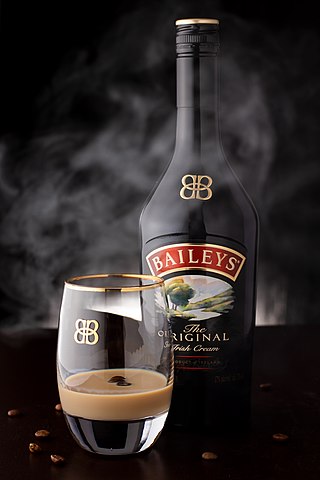
Baileys Irish Cream is an Irish cream liqueur made of cream, cocoa and Irish whiskey emulsified together with vegetable oil. Baileys is made by Diageo at Nangor Road, in Dublin, Ireland and in Mallusk, Northern Ireland. It is the original Irish cream, invented by a team headed by Tom Jago in 1971 for Gilbeys of Ireland; Diageo currently owns the trademark. It has a declared alcohol content of 17% by volume.
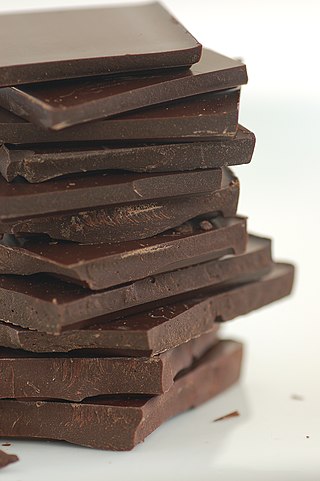
Chocolate addiction is a compulsive desire to eat chocolate despite negative consequences.
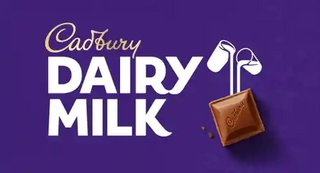
Cadbury Dairy Milk is a British brand of milk chocolate manufactured by Cadbury. It was introduced in the United Kingdom in June 1905 and now consists of a number of products. Every product in the Dairy Milk line is made with exclusively milk chocolate. In 1928, Cadbury's introduced the "glass and a half" slogan to accompany the Dairy Milk chocolate bar, to advertise the bar's higher milk content.
Decaffeination is the removal of caffeine from coffee beans, cocoa, tea leaves, and other caffeine-containing materials. Decaffeinated products are commonly termed by the abbreviation decaf. Decaffeinated drinks contain typically 1–2% of the original caffeine content, but sometimes as much as 20%.

White chocolate is a form of chocolate made of cocoa butter, sugar and milk. Unlike milk and dark chocolate, it does not contain cocoa solids, which darken the chocolate. White chocolate has an ivory color, and can smell of biscuit, vanilla or caramel, although it can also easily pick up smells from the environment, and become rancid with its relatively short shelf life. Like milk and dark chocolate, white chocolate is used to make chocolate bars and as a coating in confectionery.

A caffè mocha, also called mocaccino, is a chocolate-flavoured warm beverage that is a variant of a caffè latte, commonly served in a glass rather than a mug. Other commonly used spellings are mochaccino and also mochachino. The name is derived from the city of Mokha, Taiz Governorate, Yemen, which was one of the centres of early coffee trade. Like latte, the name is commonly shortened to just mocha.

Nudossi is a brand of sweetened hazelnut cocoa spread manufactured by the Saxon and Dresdner baking and confectionery GmbH & Co. KG ,formerly known as Vadossi. In its plastic container with a red lid, Nudossi is the manufacturer's best-known product. Well known as a product during the German Democratic Republic (GDR), it was often compared to Nutella which had been widely available outside the Communist bloc since 1965. In 1972, the company was nationalized and production was discontinued after German reunification, as demand initially dropped.
Hans Imhoff was a German chocolate producer and founder of the Imhoff-Schokoladenmuseum in Cologne, Germany.

Eurocrem is a brand of two-colored hazelnut- and cocoa-flavored sweet milk chocolate spread, produced by a Swisslion Group factory in Gornji Milanovac, Serbia, about 120 kilometres south of Belgrade.

Belgian chocolate is chocolate produced in Belgium. A major industry since the 19th century, today it forms an important part of the nation's economy and culture.

Red Bull Simply Cola is a beverage from Red Bull GmbH, makers of the energy drink Red Bull. The cola, which contains natural flavouring and caffeine, was introduced in 2008 in several countries.
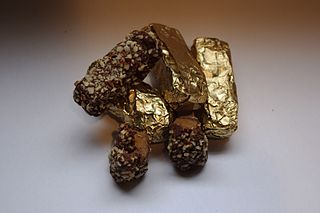
Almond Roca is a brand of chocolate-covered, hard toffee with a coating of ground almonds. It is similar to chocolate-covered English toffee. The candy is manufactured by the Brown & Haley Co. of Tacoma, Washington, founded in 1912 by Harry Brown and J.C. Haley.
The following outline is provided as an overview of and topical guide to chocolate:
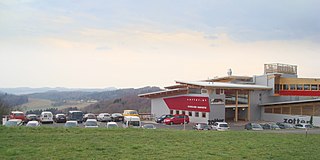
Zotter Schokolade is an Austrian chocolate manufacturer specializing in organic and fairly traded bean-to-bar chocolate. The company was founded in 1999 by Josef Zotter and is based in Riegersburg, Styria. Zotter is mostly active in German-speaking Europe, with 90 percent of distribution outlets being located in Germany, Switzerland, and Austria. As one of Austria's most well-known trademarks, Zotter is considered a national high equity brand.

Nogger is a brand of ice cream bar made by Langnese. It was first introduced in West Germany in 1964, making it one of the oldest ice cream brands of Unilever.


















